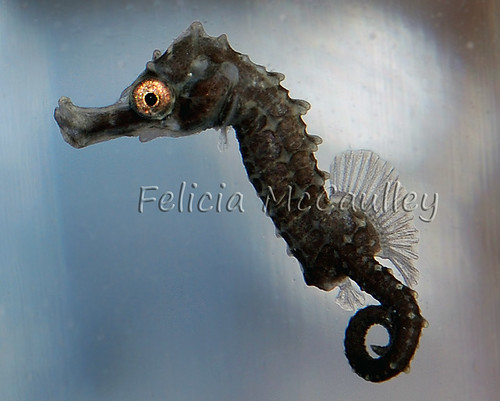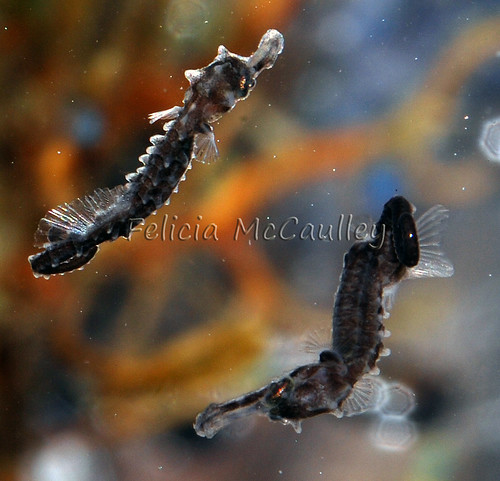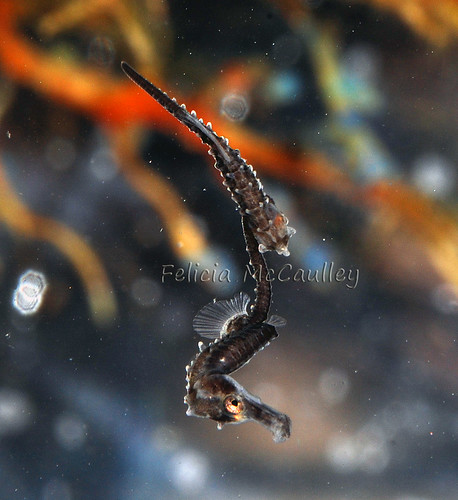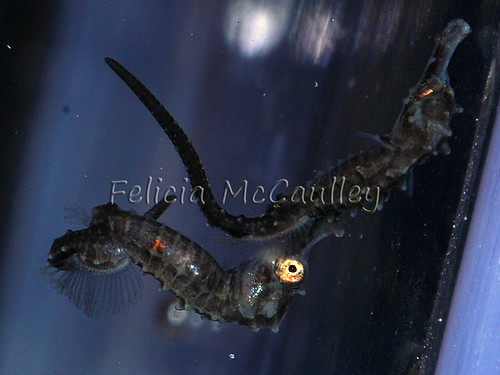Nov 19, 2010
Nov 14, 2010
Seahorses and Vibrio
The Vibrio bacteria that infect seahorses and pipefish are temperature dependent. Keeping seahorses in a chilled aquarium can greatly reduce the risk of infection or death by Vibrio bacteria.
Different species of seahorses from different parts of the world may be more or less resistant to Vibrio bacteria based on the temperatures of their native environments. The Atlantic Ocean is warmer than other oceans by about 16°F. Hippocampus erectus, H. zosterae, H. reidi and other seahorse species in the Atlantic may have had to adapt by developing stronger immunity to Vibrio bacteria, as warmer temperatures encourage growth of Vibrio, exposing the seahorses to a higher percentage of Vibrio bacteria in their environment than seahorses in other parts of the world. This may explain why H. erectus seahorses, one of the most common seahorse species in the U.S., have been identified as asymptomatic carriers of Vibrio, and when introduced to other species of seahorses can cause severe Vibrio outbreaks.
Seahorses coming from sub-tropical or temperate zones may have little to no resistance to Vibrio bacteria, especially those strains found in tropical waters. This is why it is so important to keep cool-water seahorse species at their recommended temperature and not to keep them at tropical temperatures even for a short period. Keeping cool-water seahorses with tropical seahorses, especially those from a different ocean, can expose them to strains of Vibrio to which they have no immunity.
There are steps you can take to prevent Vibrio bacterial infections in your aquarium. Invest in one or two good aquarium chillers. Steadily maintain your main tank temperature between 68°F - 74°F for tropical species. A bare bottom aquarium will help prevent build up of bacteria. Scrub the sides and bottom of the tank. Siphon feces before each feeding, and siphon uneaten food shortly after each feeding. A slightly over sized protein skimmer will help maintain water quality.
It is not recommended to mix together different species of seahorses and/or pipefish. Vibrio bacteria can even be transferred via your hands, fish nets, containers, and feeding syringes. If you plan to mix different species of seahorses or pipefish together, you are taking a risk, but you can help to minimize potential infections by quarantining your new arrivals for at least 6 weeks, preferably several months. The new seahorses must be eating perfectly and be in perfect health before introducing them to the main tank, so quarantine for as long as it takes. A UV Sterilizer could theoretically be used to "inoculate" the new seahorses to your existing seahorses' bacteria and vice versa. There is absolutely no fail-safe way to mix seahorse and/or pipefish species together and ensure they will not succumb to Vibrio infection or other transferable disease or infection.
If your tropical species of seahorse develops white, fuzzy patches of eroded skin, especially on the snout or tail, it is likely a Vibrio bacterial infection. Immediately move the seahorse to a bare bottom, sterile 10 gallon hospital/quarantine tank (or simple, plastic Sterilite storage tub/container) with a couple plastic hitches at a temperature of 68°F. Go to the Seahorse.org Emergency forum and start a thread asking for advice; include answers to these questions. Make sure you have the necessary antibiotic medications on hand such as Triple Sulfa or Furan 2 combined with Neomycin. Aggressive Vibrio infections can spread quickly and kill in as little as 24 hours, so act immediately to resolve the issue.
Different species of seahorses from different parts of the world may be more or less resistant to Vibrio bacteria based on the temperatures of their native environments. The Atlantic Ocean is warmer than other oceans by about 16°F. Hippocampus erectus, H. zosterae, H. reidi and other seahorse species in the Atlantic may have had to adapt by developing stronger immunity to Vibrio bacteria, as warmer temperatures encourage growth of Vibrio, exposing the seahorses to a higher percentage of Vibrio bacteria in their environment than seahorses in other parts of the world. This may explain why H. erectus seahorses, one of the most common seahorse species in the U.S., have been identified as asymptomatic carriers of Vibrio, and when introduced to other species of seahorses can cause severe Vibrio outbreaks.
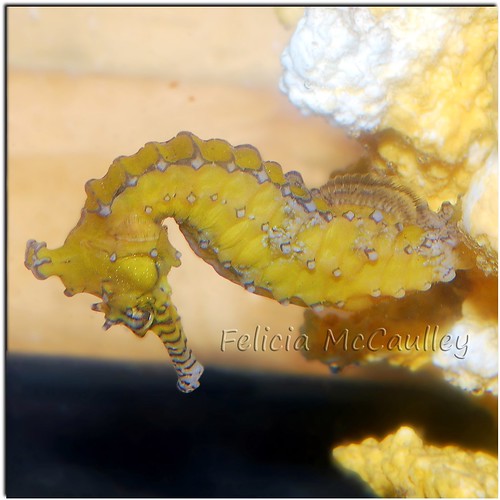 |
| a beautiful temperate H. elongatus seahorse |
Seahorses coming from sub-tropical or temperate zones may have little to no resistance to Vibrio bacteria, especially those strains found in tropical waters. This is why it is so important to keep cool-water seahorse species at their recommended temperature and not to keep them at tropical temperatures even for a short period. Keeping cool-water seahorses with tropical seahorses, especially those from a different ocean, can expose them to strains of Vibrio to which they have no immunity.
There are steps you can take to prevent Vibrio bacterial infections in your aquarium. Invest in one or two good aquarium chillers. Steadily maintain your main tank temperature between 68°F - 74°F for tropical species. A bare bottom aquarium will help prevent build up of bacteria. Scrub the sides and bottom of the tank. Siphon feces before each feeding, and siphon uneaten food shortly after each feeding. A slightly over sized protein skimmer will help maintain water quality.
It is not recommended to mix together different species of seahorses and/or pipefish. Vibrio bacteria can even be transferred via your hands, fish nets, containers, and feeding syringes. If you plan to mix different species of seahorses or pipefish together, you are taking a risk, but you can help to minimize potential infections by quarantining your new arrivals for at least 6 weeks, preferably several months. The new seahorses must be eating perfectly and be in perfect health before introducing them to the main tank, so quarantine for as long as it takes. A UV Sterilizer could theoretically be used to "inoculate" the new seahorses to your existing seahorses' bacteria and vice versa. There is absolutely no fail-safe way to mix seahorse and/or pipefish species together and ensure they will not succumb to Vibrio infection or other transferable disease or infection.
If your tropical species of seahorse develops white, fuzzy patches of eroded skin, especially on the snout or tail, it is likely a Vibrio bacterial infection. Immediately move the seahorse to a bare bottom, sterile 10 gallon hospital/quarantine tank (or simple, plastic Sterilite storage tub/container) with a couple plastic hitches at a temperature of 68°F. Go to the Seahorse.org Emergency forum and start a thread asking for advice; include answers to these questions. Make sure you have the necessary antibiotic medications on hand such as Triple Sulfa or Furan 2 combined with Neomycin. Aggressive Vibrio infections can spread quickly and kill in as little as 24 hours, so act immediately to resolve the issue.
Nov 9, 2010
Temperature Affects Marine Vibrio Bacteria
Vibrio is a genus of marine bacteria found in clams, shellfish, corals, Syngnathids, and Cholera in humans (There are even benign species such as Vibrio Fischeri responsible for bioluminescence in some species of squid and fish). Vibrio cholerae infects humans, Vibrio coralliilyticus infects certain stony corals, and Vibrio spp. infect seahorses and other Syngnathids. The preferred temperature range for growth and the temperature at which virulence increases of each of these three infectious Vibrio species is strikingly similar.
The optimal temperature for Vibrio cholerae survivability and abundance is between 68°F and 86°F. Scientists fear that global warming trends may steadily increase the number of Cholera outbreak cases. It is not surprising that Vibrio coralliilyticus and the Syngnathid-specific strains of Vibrio spp. also favor temperature conditions between 68°F and 86°F.
The Magic Numbers
The recent findings of researchers at the Hollings Marine Laboratory in Charleston, South Carolina reported by CORAL magazine (Jan/Feb 2010) show that infectious strains of Vibrio coralliilyticus linked to coral-bleaching events of small polyp stony corals are temperature dependent. Similar to the Vibrio spp. strains that infect seahorses, Vibrio coralliilyticus does not normally cause disease in healthy coral specimens at a temperature of 75°F, but becomes pathogenic at higher temperatures. Temperatures above 80°F increase the acceleration and severity of the infection.
Not much research has been done on the Syngnathid-specific strains of Vibrio, but for years seahorse aquarists have noticed a correlation between high temperatures and Vibrio bacterial infections in their pets. In the book Working Notes – A Guide to Seahorse Diseases pathologist Martin Belli M.D. writes that strains of Vibrio found to affect seahorses did not grow well in a lab at temperatures lower than 64°F. Seahorse.org members have long advocated seahorse aquarium temperatures no higher than 74°F because Vibrio becomes more aggressive and virulent at higher temperatures. Temperatures in the low 80's seem to increase number of cases, rate of infection, and chance of death.
MORE ON VIBRIO from Felicia's Aquarium Adventures:
http://aquariumadventures.blogspot.com/2010/11/seahorses-and-vibrio.html
http://aquariumadventures.blogspot.com/2010/12/seahorse-tank-keep-it-clean.html
The optimal temperature for Vibrio cholerae survivability and abundance is between 68°F and 86°F. Scientists fear that global warming trends may steadily increase the number of Cholera outbreak cases. It is not surprising that Vibrio coralliilyticus and the Syngnathid-specific strains of Vibrio spp. also favor temperature conditions between 68°F and 86°F.
The Magic Numbers
The recent findings of researchers at the Hollings Marine Laboratory in Charleston, South Carolina reported by CORAL magazine (Jan/Feb 2010) show that infectious strains of Vibrio coralliilyticus linked to coral-bleaching events of small polyp stony corals are temperature dependent. Similar to the Vibrio spp. strains that infect seahorses, Vibrio coralliilyticus does not normally cause disease in healthy coral specimens at a temperature of 75°F, but becomes pathogenic at higher temperatures. Temperatures above 80°F increase the acceleration and severity of the infection.
Not much research has been done on the Syngnathid-specific strains of Vibrio, but for years seahorse aquarists have noticed a correlation between high temperatures and Vibrio bacterial infections in their pets. In the book Working Notes – A Guide to Seahorse Diseases pathologist Martin Belli M.D. writes that strains of Vibrio found to affect seahorses did not grow well in a lab at temperatures lower than 64°F. Seahorse.org members have long advocated seahorse aquarium temperatures no higher than 74°F because Vibrio becomes more aggressive and virulent at higher temperatures. Temperatures in the low 80's seem to increase number of cases, rate of infection, and chance of death.
MORE ON VIBRIO from Felicia's Aquarium Adventures:
http://aquariumadventures.blogspot.com/2010/11/seahorses-and-vibrio.html
http://aquariumadventures.blogspot.com/2010/12/seahorse-tank-keep-it-clean.html
Subscribe to:
Comments (Atom)



